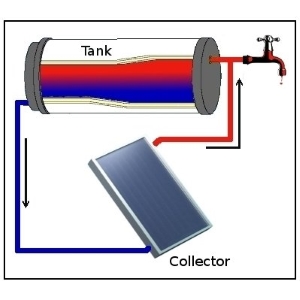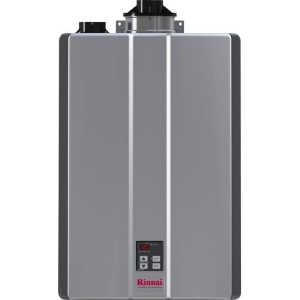- Home
- Solar water heaters
- Thermosyphon Solar Water Heater
Thermosyphon Solar Water Heaters - Ideas and Building Tips
How thermosyphon solar water heater works, advantages, and what to consider when building one. Ideas with designs on how to make your own passive solar heating system.
Highlights
How thermosyphon water heating works
 Photo: Wikipedia
Photo: WikipediaThermosyphon systems are designed to circulate naturally heated fluid from a collector (by convection and gravity), to a storage tank, and transfer the heat to water.
According to Wikipedia, "Thermosiphon (or thermosyphon) is a method of passive heat exchange, based on natural convection, which circulates a fluid without the necessity of a mechanical pump."
The thermosyphon solar water heater consists of one or more solar collectors filled with the heat transfer fluid or water and the storage tank.
Passive solar water heating systems do not require a circulating pump and controllers.
And this is one of the greatest advantages; the thermosyphon solar water heater is cheaper than the active system, saving you money. The faster the water flow is, the greater the temperature difference between the heating fluid in the panels and water in the tank. When the solar collector cools below the temperature of water in the tank, the water flow stops.
As said before, the thermosyphon solar water heater consists of the solar collector and storage tank, which is installed above the panels, either right above it (integrated system) or somewhere inside the home, such as an attic.
To make the thermosyphon system working, the storage tank should be at least one foot or 30 cm above the solar panels, which will allow hot water to rise to the top of the collector and move further into the tank (natural convection). Solar heat and gravity are what are needed for this process to work correctly.
Types
A flat plate panel is the most used collector type of passive solar water heating system. In contrast, some systems can use concentrating collectors to produce water at higher temperatures or evacuated tube collectors, known as vacuum tubes, efficient even during cloudy days.
Open-circuit system
If water is used as the heating fluid, we are talking about the open circuit systems recommended for frost-free areas.
Otherwise, the lower, freezing temperatures might freeze the water inside the pipes and cause them to burst. This is especially dangerous if the collector is not used when all the heating fluid remains in the collectors.
- Find Plumbers In Your Area -
Closed-circuit system
If the heating fluid is the antifreeze solution, we are talking about the closed-circuit thermosyphon solar water heater, and they can be used in areas prone to frost and hard water issues.
In both cases, the collector should be full of heating fluid to prevent the air pockets, and if the sediment buildup is a problem, it is recommended to use a water softener.
One of the major disadvantages of the thermosyphon systems is how to prevent the heat loss caused by reverse water circulation, especially during the night when the water temperature is low. Other ones are the danger of freezing and the system's weight (the roof might need some reinforcement).
Configuration
The solar panel has a box shape, usually made of plywood, aluminum, or stainless steel, and has a cover made of plastic or glass. The drain valve is a must to drain all the water before the winter, which allows easier maintenance and service if needed.
The recommended piping will include types such as PEX, and polyethylene, which can protect water from freezing, but the most used is copper, with solid and flexible sections. Another solution for the freeze protection system is to use the dump valves or heaters in the bottom collector.
The storage tank is usually very well insulated, so the heat loss is reduced significantly. Water from the storage tank can be used directly as potable water for a shower or indirectly, so it preheats water inside the gas or electric water heater. The most popular tank sizes are 40, 50 and 80 gallons.
Piping of the cold inlet water connects the bottom of the solar panel and storage tank, while the pipe with the hot water runs from the top of the collector to the top of the tank.
You can also purchase a solar water heater kit, which is more expensive than making your own, but the advantage is that it takes less time for installation. Look for high-quality materials, such as stainless steel construction and thick foam insulation, for reduced heat loss.
Ideas on how to build a thermosyphon solar water heater
Note: Professional installation and repair are recommended. Find local plumbers and get FREE Quotes!
Idea #1
When planning to create your own thermosyphon solar water heater, the solar panel might consist of a wooden box made of plywood, copper pipes, and aluminum sheet underneath.
Everything should be painted in black for the increased absorbance and have a glazing cover on the top. The solar panel is tilted to an adequate angle to have the best exposure to the sun and with the plumbing slope upward to have the thermosyphon flow established.
The storage tank is with the 50-gallon capacity, and the system uses the electric water heater as the backup. More about this design here.
Idea #2
This design uses the solar panel with the aluminum heat-absorbing fins and copper pipes and can be made for a few hundred bucks... more.
Idea #3
Another idea from YoutTube.
Keep in mind that the size of the solar panels is very important. If it is too small, it won't heat all the water in the tank to the desired temperature. If it is too big, it will heat water too fast and at the higher temperature. The thermosyphon solar water heater will produce enough hot water over the night by selecting the correct size.
For the DIY home project, basic carpentry, plumbing, and necessary tools are required.
Related
Leave a Comment
- Home
- Solar water heaters
- Thermosyphon Solar Water Heater


